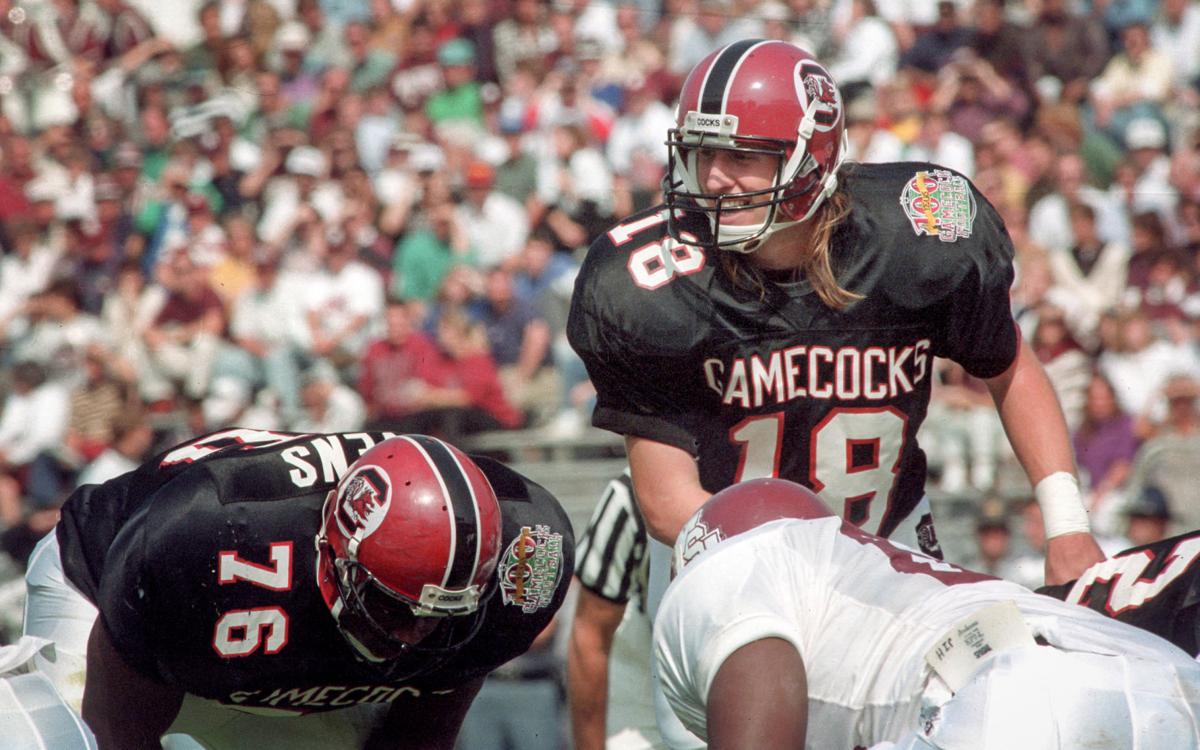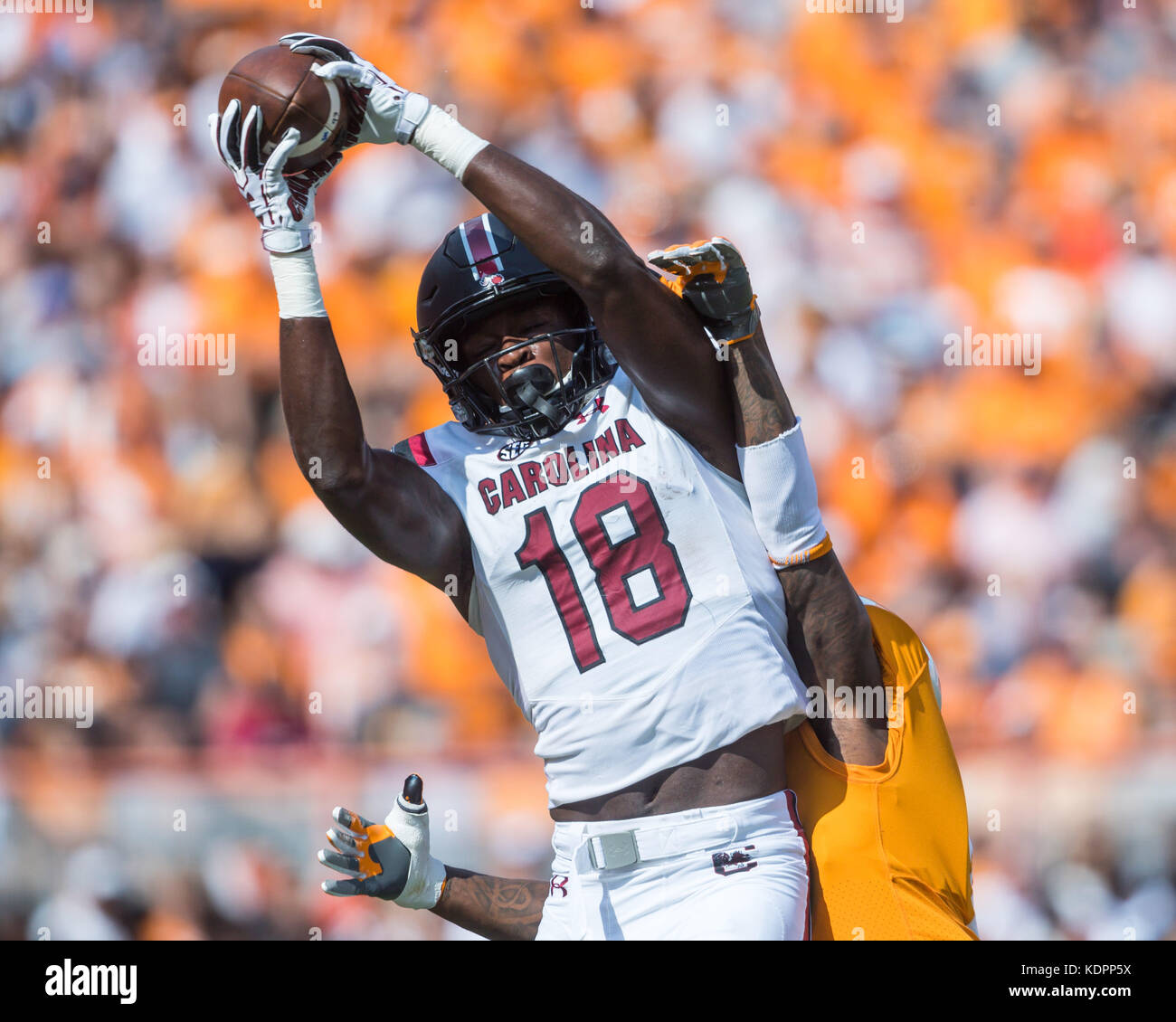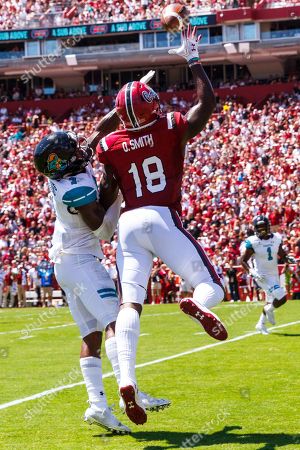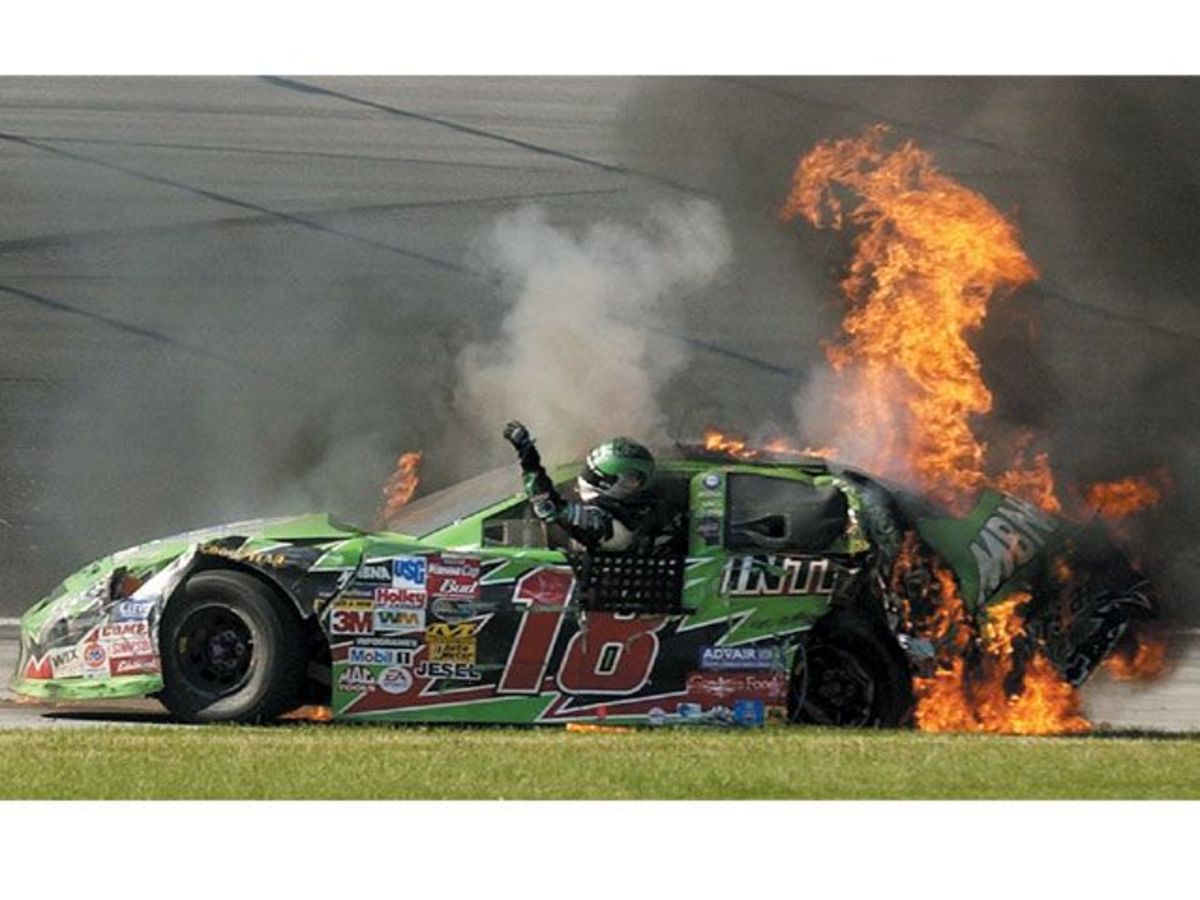Gamecock Fanatics
You are using an out of date browser. It may not display this or other websites correctly.
You should upgrade or use an alternative browser.
You should upgrade or use an alternative browser.
Countdown to Kickoff II: The Final 24 Days
- Thread starter Swayin
- Start date
Sikorsky S-18.


https://en.wikipedia.org/wiki/Sikorsky_S-18The Sikorsky S-18 was a Russian twin engine aircraft designed by Igor Sikorsky and built by the Russian Baltic Railroad Car Works aviation division at Petrograd during World War I.
Design and development
The S-18 was a large three bay biplane fighter/interceptor powered by two 150 hp (112 kW) Sunbeam Crusader V-8 water-cooled engines mounted on the lower wing in a pusher configuration. The aircraft featured armor protection for both crew members with the gunner/observer seated in the nose and armed with a single machine gun. The aircraft was very heavy and with the less than reliable Sunbeam engines neither example built was able to leave the ground.
The Douglas B-18 Bolo, America's first true heavy bomber, and based on the DC-3 airframe. First flew in 1934 and was obsolete when the war began; most were destroyed in the Philippines or at Pearl Harbor. It was underpowered, undergunned, and carried a small payload as compared to its more modern cousins. Surviving B-18s served as coastal recon aircraft or in cargo/passenger roles, although a B-18 was credited with being the first US plane to sink an enemy ship, the U-654, in the Caribbean.
.jpg)
.jpg)
Homebrewcock
GCF Top Poster
18 Yard TD.
Those two were so freakin' fun to watch.2 minutes ago, Homebrewcock said:
18 Yard TD.
Homebrewcock
GCF Top Poster
HWSNBN (joke from an old board)








Homebrewcock
GCF Top Poster
Homebrewcock
GCF Top Poster
The Doolittle Raid was flown on April 18th, 1942.
_with_USS_Gwin_(DD-433)_during_Doolittle_Raid_1942.jpg/1280px-USS_Hornet_(CV-8)_with_USS_Gwin_(DD-433)_during_Doolittle_Raid_1942.jpg)
AAF serial #
Nickname
Sqdn
Target
Pilot
40-2344
Tokyo
Lt. Col. James H. Doolittle
40-2292
37th BS
Tokyo
1st Lt. Travis Hoover
40-2270
Whiskey Pete
95th BS
Tokyo
1st Lt. Robert M. Gray
40-2282
95th BS
Tokyo
1st Lt. Everett W. Holstrom
40-2283
95th BS
Tokyo
Capt. David M. Jones
40-2298
The Green Hornet
95th BS
Tokyo
1st Lt. Dean E. Hallmark
40-2261
The Ruptured Duck
95th BS
Tokyo
1st Lt. Ted W. Lawson
40-2242
95th BS
Tokyo
Capt. Edward J. York
40-2303
Whirling Dervish
34th BS
Tokyo
1st Lt. Harold F. Watson
40-2250
89th RS
Tokyo
1st Lt. Richard O. Joyce
40-2249
Hari Kari-er
89th RS
Yokohama
Capt. C. Ross Greening
40-2278
Fickle Finger of Fate
37th BS
Yokohama
1st Lt. William M. Bower
40-2247
The Avenger
37th BS
Yokosuka
1st Lt. Edgar E. McElroy
40-2297
89th RS
Nagoya
Maj. John A. Hilger
40-2267
TNT
89th RS
Kobe
1st Lt. Donald G. Smith
40-2268
Bat Out of Hell
34th BS
Nagoya
1st Lt. William G. Farrow
https://en.wikipedia.org/wiki/Doolittle_Raid#Fate_of_the_missing_crewmen

https://en.wikipedia.org/wiki/William_G._Farrow
What it doesn't say in the link is that Lt. Farrow is the namesake for Farrow Rd. in Columbia. The State newspaper published a detailed story on Farrow around the time of the Raiders' 60th reunion in Columbia in 2002.
Thousands of people ride down Farrow Rd. or pass the exit for it on I-20 everyday without knowing who it is named for.
William G. Farrow: Doolittle Raider. Gamecock.
Sa-lute!
_with_USS_Gwin_(DD-433)_during_Doolittle_Raid_1942.jpg/1280px-USS_Hornet_(CV-8)_with_USS_Gwin_(DD-433)_during_Doolittle_Raid_1942.jpg)
AAF serial #
Nickname
Sqdn
Target
Pilot
40-2344
Tokyo
Lt. Col. James H. Doolittle
40-2292
37th BS
Tokyo
1st Lt. Travis Hoover
40-2270
Whiskey Pete
95th BS
Tokyo
1st Lt. Robert M. Gray
40-2282
95th BS
Tokyo
1st Lt. Everett W. Holstrom
40-2283
95th BS
Tokyo
Capt. David M. Jones
40-2298
The Green Hornet
95th BS
Tokyo
1st Lt. Dean E. Hallmark
40-2261
The Ruptured Duck
95th BS
Tokyo
1st Lt. Ted W. Lawson
40-2242
95th BS
Tokyo
Capt. Edward J. York
40-2303
Whirling Dervish
34th BS
Tokyo
1st Lt. Harold F. Watson
40-2250
89th RS
Tokyo
1st Lt. Richard O. Joyce
40-2249
Hari Kari-er
89th RS
Yokohama
Capt. C. Ross Greening
40-2278
Fickle Finger of Fate
37th BS
Yokohama
1st Lt. William M. Bower
40-2247
The Avenger
37th BS
Yokosuka
1st Lt. Edgar E. McElroy
40-2297
89th RS
Nagoya
Maj. John A. Hilger
40-2267
TNT
89th RS
Kobe
1st Lt. Donald G. Smith
40-2268
Bat Out of Hell
34th BS
Nagoya
1st Lt. William G. Farrow
https://en.wikipedia.org/wiki/Doolittle_Raid#Fate_of_the_missing_crewmen
William Glover Farrow (September 24, 1918 – October 15, 1942) was a lieutenant in the United States Army Air Corps who participated in the Doolittle Raid. In February 1942, he volunteered to participate in the raid, which took place on April 18 that year. Farrow was captured by the Japanese after the completion of his bombing mission. Along with two other crew members, he was tried and sentenced to death and executed by firing squad. His ashes were recovered and interred in the Arlington National Cemetery in 1946, and he posthumously received multiple awards.
Early life
William Farrow was born in Darlington, South Carolina, on September 24, 1918. His father Isaac was employed at a cigarette company in Raleigh, North Carolina; his mother Jessie, born in 1897, was the daughter of a wealthy tobacco warehouse owner. At age sixteen, William became an Eagle Scout. He graduated from St. John's High School in May 1935, and went on to attend the University of South Carolina.
Military career
During the fall of 1939, he received his pilot training at the Hawthorne School of Aeronautics in Orangeburg, South Carolina. On November 23, 1940, Farrow joined the United States Army Air Corps' Aviation Cadet Program. He joined the Air Corps training program in November 1940, and was commissioned in July 1941.
In July of the following year, he obtained his aviator badge and a commission as a second lieutenant at Kelly Field in Texas. Following his completion of the B-25 Mitchell training program, he was sent to Pendleton Field in Oregon as a member of the 34th Bomb Squadron.
Doolittle Raid
In February 1942, following the squadron's transfer to Columbia Army Air Base in January, Farrow volunteered to participate in the Doolittle Raid, an attempt to retaliate against the Japanese as a result of their attack on Pearl Harbor. At the time, however, the mission was secret and its target unknown to the volunteers. On April 1, 1942, after training in various places around the United States, the crews and their respective aircraft departed from San Francisco aboard the USS Hornet (CV-8). The mission took place on April 18. The B-25 which Farrow piloted, named Bat Out of Hell, was the sixteenth and final aircraft to depart from the Hornet. Number 16, under his command, had targeted Osaka in the plan but invaded Nagoya and bombed the city. After the aircraft's targets in Nagoya, which included an oil tank and aircraft factory, had been bombed, Farrow intended to land in Chuchow. However, the Japanese had deactivated the beacon that Farrow was using for direction.
Capture and death
Sixteen hours after departure from the Hornet, the aircraft's fuel exhausted, Farrow and his crew bailed out near Japanese-controlled Nanchang, China. The Japanese captured Farrow and all members of his crew, and subjected them to imprisonment, interrogation, and torture. The men were subsequently tried and sentenced to death. Most of the crew members' sentences were commuted to life imprisonment by the Emperor of Japan, but the sentences of three men, including Farrow, stood. The night before their execution, the men were permitted to write final letters. The International Red Cross was to mail the letters after receiving them from the Japanese. The Japanese, however, did not pass on the letters, and they were never mailed. Farrow wrote letters to his mother and to a friend, Lt. Ivan Ferguson. In the letter addressed to his mother, Farrow wrote:
"You have given much, so much more to me than I have returned, but such is the Christian way. You are and always will be a real angel. Be brave and strong for my sake. I love you, Mom, from the depths of a full heart... Don't let this get you down. Just remember God will make everything right and that I'll see you all again in the hereafter... So let me implore you to keep your chin up. Be brave and strong for my sake. P.S. My insurance policy is in my bag in a small tent in Columbia. Read Thanatopsis by Bryant if you want to know how I am taking this. My faith in God is complete, so I am unafraid."
At dawn on October 15, the men were taken to a public cemetery near Shanghai, where they were shot by a Japanese firing squad. Following the bodies' cremation, the ashes were taken to a mortuary. After the war ended, the men's ashes were recovered and their letters found in a secret file of the War Ministry Building in Tokyo. In 1946, Farrow was interred with honors at the Arlington National Cemetery, Section 12, Grave 157.

https://en.wikipedia.org/wiki/William_G._Farrow
What it doesn't say in the link is that Lt. Farrow is the namesake for Farrow Rd. in Columbia. The State newspaper published a detailed story on Farrow around the time of the Raiders' 60th reunion in Columbia in 2002.
Thousands of people ride down Farrow Rd. or pass the exit for it on I-20 everyday without knowing who it is named for.
William G. Farrow: Doolittle Raider. Gamecock.
Sa-lute!
Last edited by a moderator:
Would have been a great post even without the Gamecock connection! You've had a ton of great content in this thread since we started on Day 99, but this one deserves extra kudos!The Doolittle Raid was flown on April 18th, 1942.
AAF serial #
Nickname
Sqdn
Target
Pilot
40-2344
Tokyo
Lt. Col. James H. Doolittle
40-2292
37th BS
Tokyo
1st Lt. Travis Hoover
40-2270
Whiskey Pete
95th BS
Tokyo
1st Lt. Robert M. Gray
40-2282
95th BS
Tokyo
1st Lt. Everett W. Holstrom
40-2283
95th BS
Tokyo
Capt. David M. Jones
40-2298
The Green Hornet
95th BS
Tokyo
1st Lt. Dean E. Hallmark
40-2261
The Ruptured Duck
95th BS
Tokyo
1st Lt. Ted W. Lawson
40-2242
95th BS
Tokyo
Capt. Edward J. York
40-2303
Whirling Dervish
34th BS
Tokyo
1st Lt. Harold F. Watson
40-2250
89th RS
Tokyo
1st Lt. Richard O. Joyce
40-2249
Hari Kari-er
89th RS
Yokohama
Capt. C. Ross Greening
40-2278
Fickle Finger of Fate
37th BS
Yokohama
1st Lt. William M. Bower
40-2247
The Avenger
37th BS
Yokosuka
1st Lt. Edgar E. McElroy
40-2297
89th RS
Nagoya
Maj. John A. Hilger
40-2267
TNT
89th RS
Kobe
1st Lt. Donald G. Smith
40-2268
Bat Out of Hell
34th BS
Nagoya
1st Lt. William G. Farrow
https://en.wikipedia.org/wiki/Doolittle_Raid#Fate_of_the_missing_crewmen
https://en.wikipedia.org/wiki/William_G._Farrow
What it doesn't say in the link is that Lt. Farrow is the namesake for Farrow Rd. in Columbia. The State newspaper published a detailed story on Farrow around the time of the Raiders' 60th reunion in Columbia in 2002.
Thousands of people ride down Farrow Rd. or pass the exit for it on I-20 everyday without knowing who it is named for.
William G. Farrow: Doolittle Raider. Gamecock.
Sa-lute!
The countdown was a great idea. Lots of little historical tidbits on the web that never made it into the more well-known history books.Would have been a great post even without the Gamecock connection! You've had a ton of great content in this thread since we started on Day 99, but this one deserves extra kudos!
Was just something we came up with years and years ago on OOTS as a way of getting through theThe countdown was a great idea. Lots of little historical tidbits on the web that never made it into the more well-known history books.
 Period ... and it works! Glad you have enjoyed it - the posts from you and Blitzy, Homebrew and 88 have been awesome, for sure - and anyone else that contributed!
Period ... and it works! Glad you have enjoyed it - the posts from you and Blitzy, Homebrew and 88 have been awesome, for sure - and anyone else that contributed!Tusk (2018 Remaster)
David Bowie Criminal World (2018 Remaster)
18th Division - made up of NG soldiers from Arkansas, Louisiana, and Mississippi.
https://en.wikipedia.org/wiki/18th_Division_(United_States)

https://en.wikipedia.org/wiki/18th_Division_(United_States)


.jpg)






